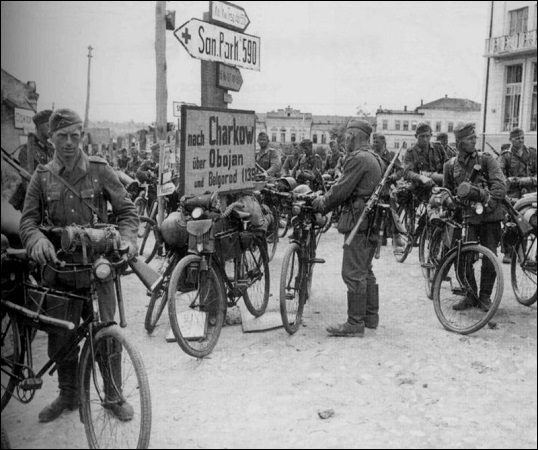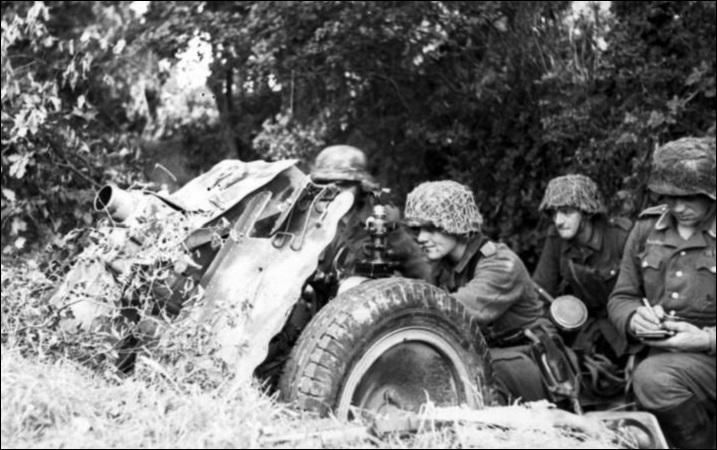● ● ●
A key component of all
German Army divisions was the
Aufklärungs-Abteilung
(reconnaissance battalion), and it was much more than a scout unit. German tactical
doctrine held that reconnaissance meant fighting for
information. The primary mission of the reconnaissance battalion was
to gain contact the enemy, then simulate a full-scale attack
so as to compel him to deploy his forces—this to reveal his
composition and strength while buying time for friendly units
to react. The reconnaissance battalion
could also be employed as the divisional reserve, often with
additional units attached. To carry out these
missions, it had to be both mobile and well armed.
In the
Type 1939
Infanterie-Division, the
standard reconnaissance battalion consisted of a
headquarters section with two light armored cars, a bicycle
infantry company, a cavalry company, a motorized heavy
platoon with support weapons and a signal platoon with
radio and telephone sections. Three of the signal sections
were motorized and two relied on pack horses. The signal
platoon was a key element of the battalion, whose ability to
communicate with the division headquarters and
other units was essential to its effectiveness.
A few infantry
divisions of the first four mobilization waves
(Aufstellungswellen)
had only a cavalry company but the intention was to
provide all divisions with a full reconnaissance battalion when resources
became available. Thus most of the divisions that lacked
them eventually acquired one, but
thanks to equipment and personnel shortages some elements,
such as the infantry gun platoon, were sometimes omitted. It
should also be noted that most infantry regiments included a
cavalry platoon that could serve as an
additional
scout unit if necessary.

Troops of a bicycle
infantry company in Russia, 1942 (Bundesarchiv)
Reconnaissance
battalions of the 2nd and 3rd Waves had a second bicycle infantry company in place of
the cavalry company. The bicycle was a cheap and relatively
effective mobility multiplier in western and central Europe,
where the road network was well developed. An additional
advantage was that bicycles required little specialized
training; most recruits already knew how to ride one. The
bicycle used by the German Army was purpose built,
incorporating carrying clips for the troops’ weapons and
equipment. Farther east,
however, where surfaced roads were sparse, cavalry was more
useful. But horses were far more expensive to acquire and
maintain than bicycles,
and it took considerable time to train a cavalryman.
The bicycle infantry
company had three rifle platoons and a heavy machine gun (HMG)
section. Each platoon had 3 x light machine guns (LMG); the HMG
section had 2 x HMG and was mounted
on motorcycles. Bicycle platoons of the 1st Wave divisions
also had a 50mm mortar. The cavalry company was similarly armed
except that it had no mortars and all personnel were on
horseback.
The heavy company of the
reconnaissance battalion was motorized and it consisted of a
headquarters section and two platoons: one with 2 x 75mm infantry gun (IG) and one
with 3 x 37mm antitank guns (ATG). As noted above,
however, not all these elements could be provided to every
division. Thus the reconnaissance battalions of the 4th Wave
had no armored car section or heavy company headquarters
element, the IG and ATG platoons being attached directly to
the battalion headquarters. Subsequent waves had only a
bicycle infantry company, which sometimes was independent
and sometimes was placed in the divisional antitank
battalion. Only with the 11th Wave was a return made to a
full reconnaissance battalion.

A 75mm light infantry gun
in action (Bundesarchiv)
Thus by 1941 there was no
longer any pretense of a standard infantry division
reconnaissance battalion. Newly raised divisions got
whatever was available at the time, most often a bicycle
infantry company. And with the advent of the Type 1944
Infanterie-Division, the infantry reconnaissance battalion
disappeared from the table of organization. In its place was
provided a so-called Füsilier-Bataillon with three rifle
companies and a heavy company. It was virtually identical to
the standard infantry battalion except that one rifle
company was mounted on bicycles to provide a reconnaissance
capability. The heavy company had 6 x HMG, 6 x 81mm mortars and 4 x 120mm mortars. Only the 120mm
mortar platoon was motorized. Thus the fusilier battalion
lacked the mobility of the old reconnaissance battalion.
Nonetheless it was tasked with the reconnaissance
mission—which it was but marginally capable of carrying out.
In the Volksgrenadier-Division the fusilier battalion was deleted and replaced
with a bicycle fusilier company. Basically this was a VG
infantry company with a heavy weapons platoon and an IG
platoon added. Though fairly mobile, it lacked the firepower
of the fusilier battalion and could serve only as a scout unit.
Given the great
importance that the German Army placed on reconnaissance,
the demise of the infantry division reconnaissance battalion
was yet another indicator of how acute the manpower
shortage had become by 1944. Bit by bit, the specialized
capabilities on which the Army’s tactical superiority rested
had eroded away: a major contributor to Germany’s defeat.